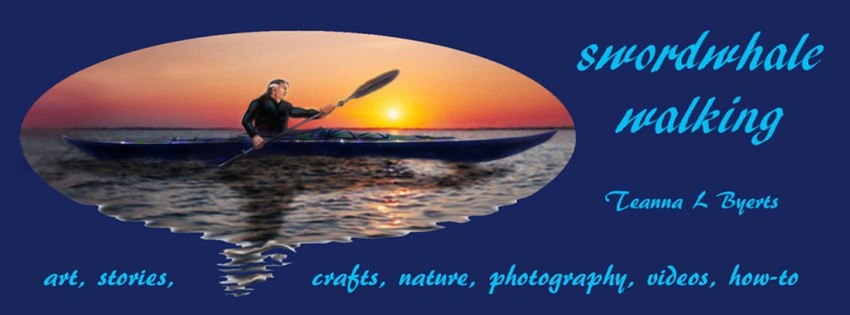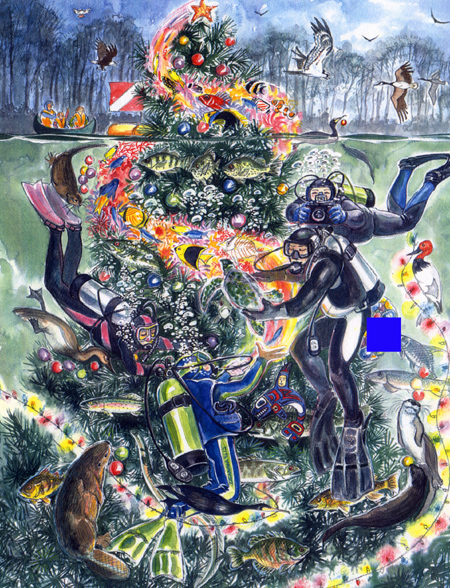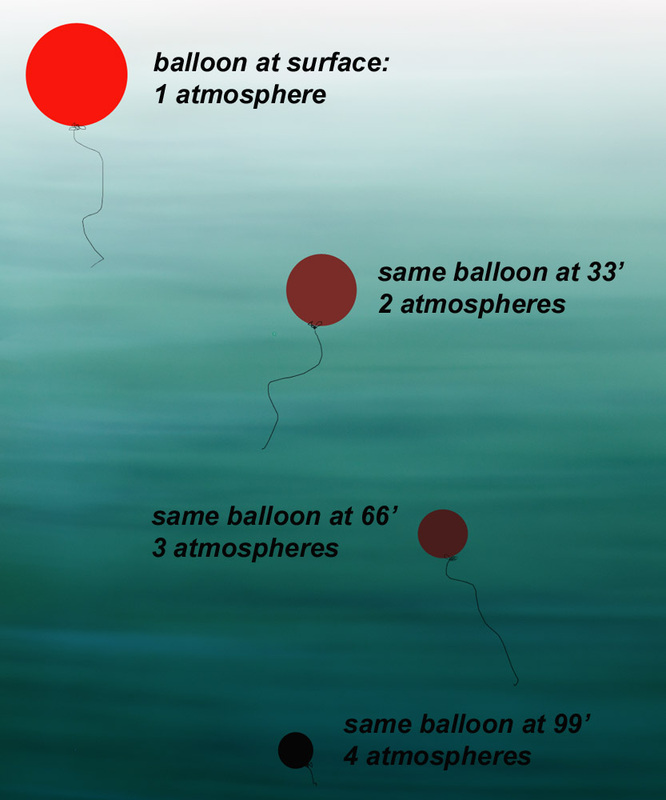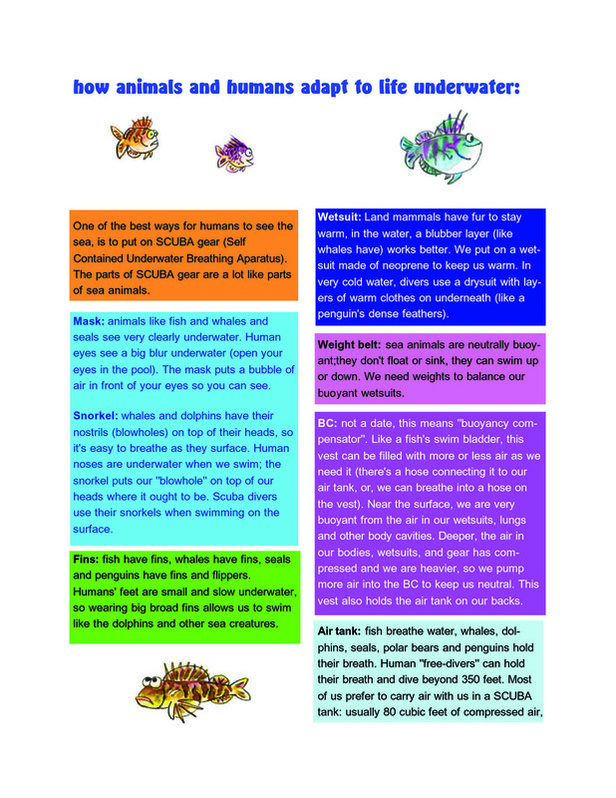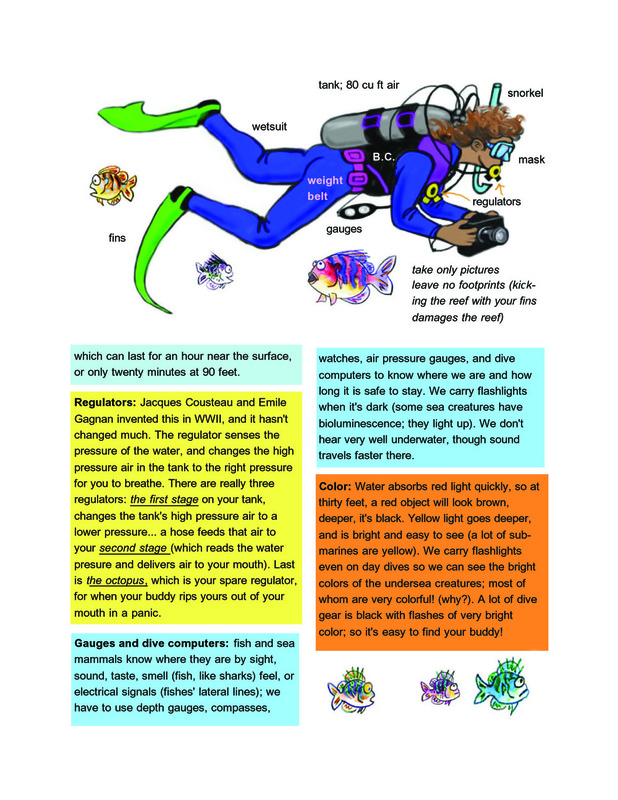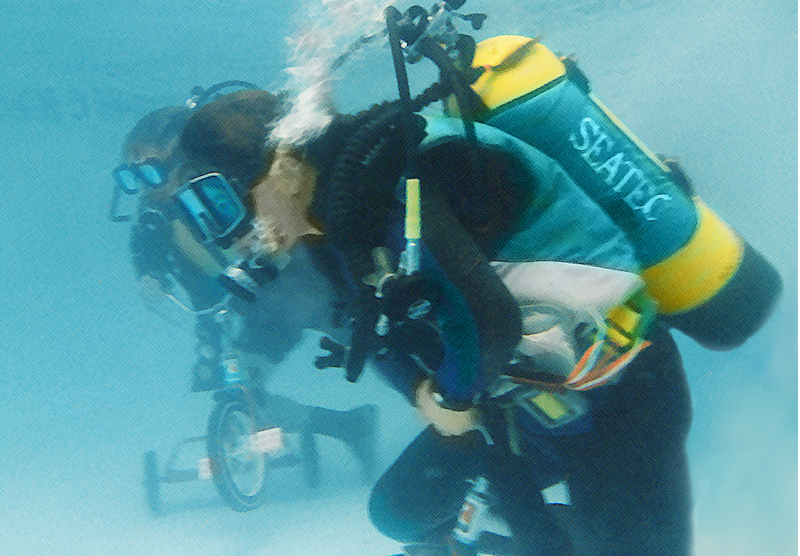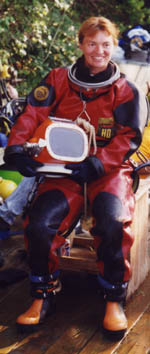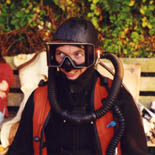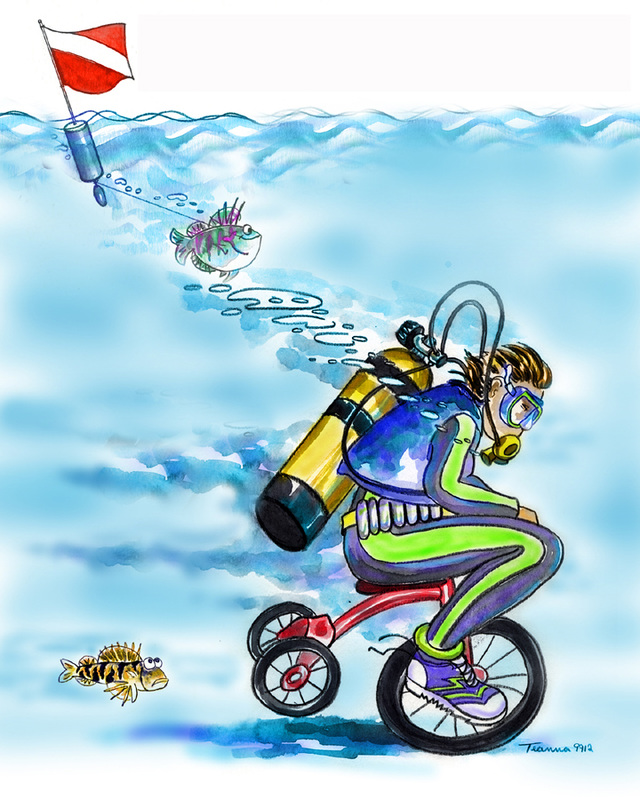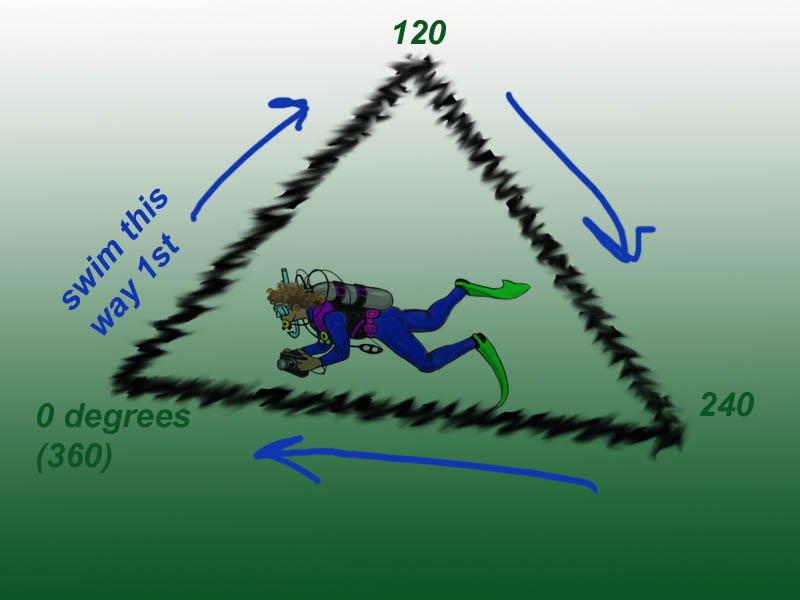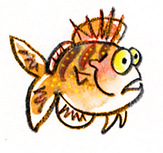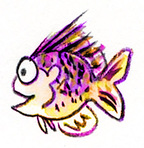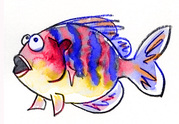I grew up on Flipper, Sea Hunt, and Jaques Cousteau specials. My parents were Pennsylvania Dutch farm-spawned landlubbers, so I never saw the sea until I was twelve (with an aunt). I spent a few years sploshing around in the temporary spring wetland in our lower pasture, sort of learning to swim at the local lake (dragging parents there was like pulling shark teeth), backrolling off rafts in the local pool (with mask and fins, just like I saw divers do on TV). I journeyed to the islands of Assateague and Chincoteague, hiked, biked and swam, and even donned snorkel and fins to surf the surfline for shells. I assumed I would learn to dive when I got rich enough to afford a vacation to BonAire. I was nearly forty when I began seeing, like a weird Sign from the Guardians of the Deep, dive flags, everywhere. (It's a red square with a white slash across it); a ski jacket in a restaurant thrown over a chair formed a red square with the iconic white slash... a barn window had a diagonal white bar across it, forming a neat dive flag... Then the actual dive flag waving over a picnic table at the local state park, and the dive club there promoting its sport and membership. I still wasn't rich, but, hey, join the club, maybe learn something, maybe...
A few weeks later I was at the bottom of a pool in borrowed gear, breathing compressed air. A few months later, I was in a class, buying and borrowing used gear, and getting my open water certification. It wasn't as hard as I thought, and it doesn't have to be expensive. I dived mainly in local quarries, set up for SCUBA, on a few offshore dives on shipwrecks from the early 1900s, in the St. Lawrence (clear and warm, with intact wooden schooners sitting at the bottom), and in Chincoteague's shallow bays. I've decorated Christmas trees and carved pumpkins underwater (these mundane excercises become very weird underwater!), got lost in a very small shipwreck, been harassed by the Bainbridge pirhanas, er, bluegills for the hotdogs I was carrying, watched Chincoteague's night life, seen catfish guarding their baby ball (fry swimming tightly in a ball), and lost an entire 400 foot shipwreck (I just turned around and it was gone... ok, so the visability was about twenty feet...).
Diving has many grandfathers, the ones who first free dived for pearls, shells and sponges, the ones who experimented with diving bells and submarines, the ones who invented ways to carry air beneath the waves...and especially Jaques Cousteau and Emile Gagnan who gave us the Aqualung, the gear that we still use to explore Planet Ocean.
how it works
The most important thing to know is: air squashes, water doesn't.
This affects everything we do underwater.
This affects everything we do underwater.
Notice how the balloon changed size: at 33' (2 atmospheres) it is half its size at the surface. At 66', (3 atmospheres) 1/3 its surface size. At 99', (4 atmospheres) 1/4th its surface size. (Notice the relationship between the size and the atmospheres of pressure? The air in the balloon compresses as the balloon descends or goes down. It will expand as the balloon ascends or comes back up).
It also changes color: Why? Red light is absorbed sooner by water. A yellow balloon would still be yellow at 66'. A lot of submarines are yellow. A lot of dive gear is black with flashes of bright color. We carry dive lights, even in clear water, even in the daytime, so we can see the real colors of the critters on the bottom.
Your lungfull of air is also squashed; you'll still breathe a lungful at 99', but it is compressed (to match the water pressure) and will be 4x as dense as the lungful at the surface. If you ascend holding your breath, the air will expand, perhaps forcing a bubble through your lung lining, into your bloodstream! This is an embolism, and can block blood flowing to important things like your heart or brain! Baaaaaad!
You'll also be breathing more nitrogen: (which makes up most of air), and your blood will be absorbing more nitrogen. Which is why we surface slowly (to let the nitrogen "offgas"), and why we can't stay long at great depths (about 20 minutes at 80 feet). Staying to deep or too long creates "the bends", or decompression sickness.
It also changes color: Why? Red light is absorbed sooner by water. A yellow balloon would still be yellow at 66'. A lot of submarines are yellow. A lot of dive gear is black with flashes of bright color. We carry dive lights, even in clear water, even in the daytime, so we can see the real colors of the critters on the bottom.
Your lungfull of air is also squashed; you'll still breathe a lungful at 99', but it is compressed (to match the water pressure) and will be 4x as dense as the lungful at the surface. If you ascend holding your breath, the air will expand, perhaps forcing a bubble through your lung lining, into your bloodstream! This is an embolism, and can block blood flowing to important things like your heart or brain! Baaaaaad!
You'll also be breathing more nitrogen: (which makes up most of air), and your blood will be absorbing more nitrogen. Which is why we surface slowly (to let the nitrogen "offgas"), and why we can't stay long at great depths (about 20 minutes at 80 feet). Staying to deep or too long creates "the bends", or decompression sickness.
|
What bored divers do when they can't get to Bon-Aire...
The DEEP Dive Club held underwater tricycle races (in a pool) in January. The money we raised went to charities. While it looks simple, it wasn't. First, you had to put a lot of weight in your belt (40 pounds for me) to keep the trike on the bottom. You couldn't actually peddle, you had to push the bike with your feet. This tended to push your butt off the seat, and the trike off the bottom. You are also pushing against dense water, not thin air (it's much easier to swim horizontal like a dolphin than walk or peddle vertical like a human). |
fun stuff to try on landYou can learn something about diving (or teach other kids) by doing some of these...
The best modern freedivers (holding their breath without SCUBA) can: hold their breath for 11 minutes and 35 seconds... swim 273 meters (over 800 feet) in a pool in one breath...dive 142 meters straight down (with the help of a weighted "sled"). How far can you swim in a pool on one breath? How far can you walk on land in one breath? (How many times can you walk across a room?) How many minutes can you hold your breath? Blubber layer test: if you have a neoprene glove, put a gloved hand in ice water, and a bare hand in the same water. How does the gloved hand feel? How about the bare hand? You can also do this with a ziplock bag and some shortening (like Crisco) or butter. Put hand in bag, smear goo/lard/"blubber" on outside (very thick)...put both hands (one bare, one in blubber bag) in cold water. Which one stays warmer? |
Compass test: to learn to navigate underwater, we had to do a triangular compass course (the visibility was about 20 feet, not enough to see where we were going). We start at the dive platform, set a course (to 120 degrees on the compass), swim fifty finbeats (steps). When we reached fifty "steps", we turned, set a new course to 240 degrees, swim fifty finbeats... stop, turn to 360 (0 on the compass), swim fifty... and we are back at our starting point. You can do this in your yard, with a towel over your head so you can't see where you are going, only the compass, and the ground). Take any number of steps, just make each side of the triangle the same amount of steps. And don't do it where you'll run into dangerous obstacles like roads or stairs. You can also do squares or straight lines or other shapes.
click the fish for cool places in PA to dive and snorkel
(if you live somewhere else, just google it)
where can you dive and snorkel?
Snorkelers of the Caribbean: Of course the most exciting diving is in warm, clear water; Bon-Aire, Bahamas, the Caribbean (minus the pirates), the Great Barrier Reef, Costa Rica, and islands in the Pacific Ocean. Even the Arctic and Antarctica offer great diving (1000 feet of visibility) if you have expensive special equipment. In most landbound places, local lakes and quarries offer scuba diving sites. Even a clear stream with pools deep enough to stick your face in can be fun.
Scuba/snorkelling quarries: In PA, we have no natural lakes (lots of streams, creeks and rivers) except for that really big one in the northwest corner (Lake Erie). We do have a lot of quarries (dug for our rich mineral resources). When you dig a hole that big, you install pumps to keep out the groundwater. When you stop quarrying, you turn off the pumps, and the quarry fills with clear, springfed water. These are stocked with fish (bluegill, bass, catfish), other life finds its way in, and you have a great dive site! Scuba quarries are also open for snorkelling, and some, like Dutch Springs, have climbing walls, a swimming area where you can climb and jump off of large inflatable "icebergs" and other toys, picnic areas and other family fun. Scuba quarries have dive shops where you can buy or rent gear. Quarries that are off limits to the public become dangerous when people go swimming without safety gear, think they can swim better than they actually can, jump off cliffs or rocks (striking underwater rocks), or dive into the cold depths and can't make it back to the surface. Quarries set up for diving and snorkelling are geared for safety.
Safety: To scuba dive, you must have a certification card (priving you have taken a scuba course) and a buddy. To snorkel, you only need mask, fins, snorkel and FLOTATION! Scuba divers have safety gear among their equipment; an inflatable BC, a quick release weight belt, extra regulator, snorkel (for swimming on the surface), a buoyant wetsuit, a whistle. Snorkellers should also have safety gear; a whistle is great, a light wetsuit (a couple hours in the surface waters of the quarry will make you chilly!), flotation; that can be a PFD (like you'd use for fishing or boating), a snorkelling vest (you can rent one at the dive shop), a wetsuit (you can rent one), or a diver's BC. Inner tubes and pool noodles don't count, although they are an extra bit of fun!
The landlocked sea: Quarries have gorgeous clear water, often a nice Caribbean blue from the top of the cliffs. They have no currents, no undertow. It is still, clear water. It is often quite deep (Bainbridge has an area called the Trench which goes to 120 feet).
Quarries (and freshwater lakes) have a layer of sun-warmed water on the surface (from two feet to fifteen feet deep). In Bainbridge, the thermocline is about 15 feet down. You can drop through it vertically and see the line in the water between the warm surface water and the cold water below. You can swim over the thermocline in warm water, stick a hand down into "the freezer". If you are snorkelling, the deeper colder water can be quite a shock!
In freshwater, light doesn't penetrate down very far to fuel plant growth, so all the cool stuff is in the first 20 feet; plants, fish, warm clear water.
There are "mermaid castles" of plants woven together by wind moving the water. There are freshwater jellyfish like snowflakes drifting through the water. There are sunken forests. Downed trees with fish for leaves. A meadow of grasses waving underwater as you fly overhead. Bluegills scrape out gravel-nests in June, hanging guard over them, staring you in the eye as you go face to face with them. They'll eat hot dogs out of your hands, or taste your thumb as you pull off a dive glove to carve an underwater pumpkin in October. (They don't have teeth). You may see a Northern Water Snake making S-curves across the surface (they're non-venomous, and harmless, if you stay a few feet away). You might surface and come eye to eye with a duck, sitting on her nest. You can swim through a schoolbus, do gymnastics on the ladder of a sunken firetruck, swim through the wreck of an old fishing boat. You can decorate an underwater Christmas tree; light fluffly garland become a mighty monster of the deep as you wrestle it into place... styrofoam satin balls compress, the thread wafts off, and they hang UP! You can dive on New Year's Eve, crunching through freshly fallen snow in your wetsuit, going BRRRRRRRRRR! as the 40 degree water seeps into your wetsuit, then warms. You drift through the dark, your buddy ahead like a strange dark angel outlined by his own divelights. You pass the underwater Christmas tree and find a bluegill chilling out in its branches among the ornaments.
I did much of my diving in a quarry called Bainbridge, near Bainbridge PA, by the Susquehanna River. It has since closed.
Most dive shops do lessons and classes. Many do something they call "Discover Scuba" where you can try the dive gear in the safety of a pool. There are dive clubs. Check it out, and have your own adventure!
Scuba/snorkelling quarries: In PA, we have no natural lakes (lots of streams, creeks and rivers) except for that really big one in the northwest corner (Lake Erie). We do have a lot of quarries (dug for our rich mineral resources). When you dig a hole that big, you install pumps to keep out the groundwater. When you stop quarrying, you turn off the pumps, and the quarry fills with clear, springfed water. These are stocked with fish (bluegill, bass, catfish), other life finds its way in, and you have a great dive site! Scuba quarries are also open for snorkelling, and some, like Dutch Springs, have climbing walls, a swimming area where you can climb and jump off of large inflatable "icebergs" and other toys, picnic areas and other family fun. Scuba quarries have dive shops where you can buy or rent gear. Quarries that are off limits to the public become dangerous when people go swimming without safety gear, think they can swim better than they actually can, jump off cliffs or rocks (striking underwater rocks), or dive into the cold depths and can't make it back to the surface. Quarries set up for diving and snorkelling are geared for safety.
Safety: To scuba dive, you must have a certification card (priving you have taken a scuba course) and a buddy. To snorkel, you only need mask, fins, snorkel and FLOTATION! Scuba divers have safety gear among their equipment; an inflatable BC, a quick release weight belt, extra regulator, snorkel (for swimming on the surface), a buoyant wetsuit, a whistle. Snorkellers should also have safety gear; a whistle is great, a light wetsuit (a couple hours in the surface waters of the quarry will make you chilly!), flotation; that can be a PFD (like you'd use for fishing or boating), a snorkelling vest (you can rent one at the dive shop), a wetsuit (you can rent one), or a diver's BC. Inner tubes and pool noodles don't count, although they are an extra bit of fun!
The landlocked sea: Quarries have gorgeous clear water, often a nice Caribbean blue from the top of the cliffs. They have no currents, no undertow. It is still, clear water. It is often quite deep (Bainbridge has an area called the Trench which goes to 120 feet).
Quarries (and freshwater lakes) have a layer of sun-warmed water on the surface (from two feet to fifteen feet deep). In Bainbridge, the thermocline is about 15 feet down. You can drop through it vertically and see the line in the water between the warm surface water and the cold water below. You can swim over the thermocline in warm water, stick a hand down into "the freezer". If you are snorkelling, the deeper colder water can be quite a shock!
In freshwater, light doesn't penetrate down very far to fuel plant growth, so all the cool stuff is in the first 20 feet; plants, fish, warm clear water.
There are "mermaid castles" of plants woven together by wind moving the water. There are freshwater jellyfish like snowflakes drifting through the water. There are sunken forests. Downed trees with fish for leaves. A meadow of grasses waving underwater as you fly overhead. Bluegills scrape out gravel-nests in June, hanging guard over them, staring you in the eye as you go face to face with them. They'll eat hot dogs out of your hands, or taste your thumb as you pull off a dive glove to carve an underwater pumpkin in October. (They don't have teeth). You may see a Northern Water Snake making S-curves across the surface (they're non-venomous, and harmless, if you stay a few feet away). You might surface and come eye to eye with a duck, sitting on her nest. You can swim through a schoolbus, do gymnastics on the ladder of a sunken firetruck, swim through the wreck of an old fishing boat. You can decorate an underwater Christmas tree; light fluffly garland become a mighty monster of the deep as you wrestle it into place... styrofoam satin balls compress, the thread wafts off, and they hang UP! You can dive on New Year's Eve, crunching through freshly fallen snow in your wetsuit, going BRRRRRRRRRR! as the 40 degree water seeps into your wetsuit, then warms. You drift through the dark, your buddy ahead like a strange dark angel outlined by his own divelights. You pass the underwater Christmas tree and find a bluegill chilling out in its branches among the ornaments.
I did much of my diving in a quarry called Bainbridge, near Bainbridge PA, by the Susquehanna River. It has since closed.
Most dive shops do lessons and classes. Many do something they call "Discover Scuba" where you can try the dive gear in the safety of a pool. There are dive clubs. Check it out, and have your own adventure!
